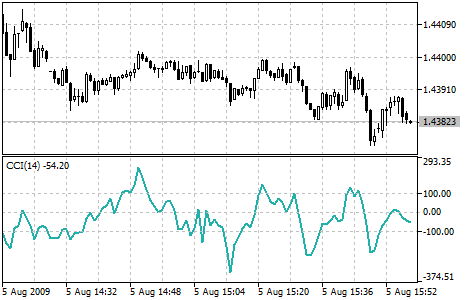Join our fan page
- Views:
- 24323
- Rating:
- Published:
- 2010.01.26 11:08
- Updated:
- 2016.11.22 07:32
-
Need a robot or indicator based on this code? Order it on Freelance Go to Freelance
Commodity Channel Index technical indicator (CCI) measures the deviation of the commodity price from its average statistical price.
High values of the index point out that the price is unusually high being compared with the average one, and low values show that the price is too low. In spite of its name, the Commodity Channel Index can be applied for any financial instrument, and not only for the commodities.
There are two basic techniques of using Commodity Channel Index:
- Finding the divergences. The divergence appears when the price reaches a new maximum, and Commodity Channel Index can not grow above the previous maximums. This classical divergence is normally followed by the price correction.
- As an indicator of overbought/oversold states of the market. Commodity Channel Index usually varies in the range of ±100. Values above +100 inform about overbought state (and about a probability of correction), and the values below 100 indicates the oversold state (and about a probability of price increase).

Commodity Channel Index indicator
Calculation:
1. To find a Typical Price. You need to add the HIGH, the LOW, and the CLOSE prices of each bar and then divide the result by 3:
TP = (HIGH + LOW + CLOSE) / 3
2. To calculate the n-period Simple Moving Average of Typical Prices:
SMA (TP, N) = SUM (TP, N) / N
3. To subtract the received SMA(TP, N) from Typical Prices of each of preceding n periods:
D = TP - SMA (TP, N)
4.To calculate the n-period Simple Moving Average of absolute D values:
SMA (D, N) = SUM (D, N) / N
5. To multiply the received SMA(D, N) by 0,015:
M = SMA (D, N) * 0,015
6. To divide M by D:
CCI = M / D
where:
- HIGH - maximum bar price;
- LOW - minimum bar price;
- CLOSE - close price;
- SMA - Simple Moving Average;
- SUM - sum;
- N - number of periods used for calculation.
Translated from Russian by MetaQuotes Ltd.
Original code: https://www.mql5.com/ru/code/18
 BW-ZoneTrade
BW-ZoneTrade
The Indicator paints the bars according to the Trade Zones, as proposed by Bill Williams.
 Bears Power
Bears Power
The Bears Power Indicator measures the balance of the bears strength.
 Chaikin Oscillator (CHO)
Chaikin Oscillator (CHO)
The Chaikin's Oscillator (CHO) is the difference of moving averages of Accumulation/Distribution.
 Chaikin Volatility (CHV)
Chaikin Volatility (CHV)
Chaikin's volatility indicator calculates the spread between the maximum and minimum prices. It judges the value of volatility basing on the amplitude between the maximum and the minimum. Unlike Average True Range, Chaikin's indicator doesn't take gaps into account.